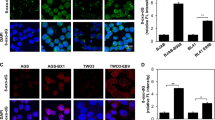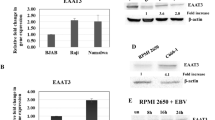Abstract
The study investigates the direct effect of Epstein-Barr virus infection on the oxidative profile of in vitro cultivated human cells. For this purpose, a panel of human EBV target cells presenting heterogeneity in their cellular and culture types (epithelial cells or lymphocytes; primary culture or continuous cell culture) was selected. These cells are purified human B lymphocytes, DG75, 293, and HepG2 cell lines. The oxidative stress was evaluated during the early stages of infection (2, 12, and 24 h) by measuring malondialdehyde, the end product of the lipid peroxidation, as well as the activities of two antioxidant enzymes: catalase and superoxide dismutase. The obtained results were compared with those of the untreated cells and the K562 cell line which has no interaction with EBV. The incubation of the different target cells with EBV induced an oxidative stress in the purified B lymphocytes, DG75, and 293, but not in HepG2 and K562. This oxidative stress was highlighted by an increase in MDA level (P < 0.05), which began 2 h after the addition of the virus and persisted after 12 and 24 h. Simultaneously, a decrease in catalase and superoxide dismutase activities was observed (P < 0.05), suggesting an alteration of the molecular mechanisms promoting cellular resistance to reactive oxygen species (ROS). The efficiency of EBV infection, assessed by viral DNA PCR amplification, was confirmed in 293 and DG75 but not in HepG2, which was in total concordance with their oxidative profiles. In conclusion, the EBV infection of B and epithelial cells leads to the establishment of an oxidative stress which can play a key role during the viral transformation.


Similar content being viewed by others
Abbreviations
- MDA:
-
Malondialdehyde
- CAT:
-
Catalase
- SOD:
-
Superoxide dismutase
- EBV:
-
Epstein-Barr virus
- LCL:
-
Lymphoblastoid cell line
- ROS:
-
Reactive oxygen species
- TBARS:
-
Thiobarbituric acid reactive species
- PCR:
-
Polymerase chain reaction
- H:
-
Hour
References
Rickinson AB, Kieff E (1996) Epstein-Barr virus. In: Knipe DM, Howley PM, Griffin DE, Lamb RA, Martin MA, Roizman B Straus SE (eds) Fields virology. Lippincott Williams & Wilkins, Philadelphia, Pa, pp 1922–1956
Raab-Traub N, Flynn K, Pearson G et al (1987) The differentiated form of nasopharyngeal carcinoma contains Epstein-Barr virus DNA. Int J Cancer 15:25–29
Dambaugh T, Nkrumah FK, Biggar RJ et al (1979) Epstein-Barr virus RNA in Burkitt tumor tissue. Cell 16:313–322
Van Rees BP, Caspers E, zur Hausen A et al (2002) Different pattern of allelic loss in Epstein-Barr virus-positive gastric cancer with emphasis on the p53 tumor suppressor pathway. Am J Pathol 161:1207–1213
Tong JH, Tsang RK, Lo KW et al (2002) Quantitative Epstein-Barr virus DNA analysis and detection of gene promoter hypermethylation in nasopharyngeal (NP) brushing samples from patients with NP carcinoma. Clin Cancer Res 8:2612–2619
Liu MY, Chang YL, Ma J et al (1997) Evaluation of multiple antibodies to Epstein-Barr virus as markers for detecting patients with nasopharyngeal carcinoma. J Med Virol 52:262–269
Lo KW, To KF, Huang DP (2004) Focus on nasopharyngeal carcinoma. Cancer cell 5:423–428
Young LS, Murray PG (2003) Epstein-Barr virus and oncogenesis: from latent genes to tumours. Oncogene 22:5108–5121
Nanbo A, Ijoue K, Adachi-takasawa K et al (2002) Epstein-Barr virus RNA confers resistance to interferon-alpha-induced apoptosis in Burkitt’s lymphoma. EMBO J 21:954–965
Cerimele F, Battle T, Lynch R et al (2005) Reactive oxygen signaling and MAPK activation distinguish Epstein-Barr virus (EBV)-positive versus EBV-negative Burkitt’s lymphpoma. Proc Natl Acad Sci 102:175–179
Lo AKF, Lo KW, Tsao SW et al (2006) Epstein-Barr virus infection alters cellular signal cascades in human nasopharyngeal epithelial cells. Neoplasia 8:173–180
Dalpke AH, Reiner T, Ritter K (2003) Oxidative injury to endothelial cells to Epstein-Barr virus-induced autoantibodies against manganese superoxide dismutase. J Med Virol 71:408–416
Su Y, Xia YF, Yang HL et al (2003) Changes of superoxide dismutase (SOD) and metallothionien (MT) before, during, and after radiotherapy for nasopharyngeal carcinoma and their significance. Ai Zheng 22:629–633
Segawa Y, Oda Y, Yamamoto H et al (2008) Overexpression of inducible nitric oxide synthase and accumulation of 8-OHdG in nasopharyngeal carcinoma. Histopathology 52:213–223
Semrau F, Kühl RJ, Ritter S et al (1998) Manganese superoxide dismutase (MnSOD) and autoantibodies against MnSOD in acute viral infections. J Med Virol 55:161–167
Valko M, Leibfritz D, Moncol J et al (2007) Free radicals and antioxidants in normal physiological functions and human disease. Int J Biochem Cell Biol 39:44–84
Imai S, Nishikawa J, Takada K (1998) Cell-to-cell contact as an efficient mode of Epstein–Barr virus infection of diverse human epithelial cells. J Virol 72:4371–4378
Fingeroth JD, Diamond ME, Sage DR et al (1999) CD21-Dependent infection of an epithelial cell line, 293, by Epstein–Barr virus. J Virol 73:2115–2125
Trivedi P, Spinsanti P, Cuomo L et al (2001) Differential regulation of Epstein-Barr virus (EBV) latent gene expression in Burkitt lymphoma cells infected with a recombinant EBV strain. J Virol 75:4929–4935
Ben-Bassat H, Goldblum N, Mitrani S et al (1977) Establishment in continuous culture of a new type of lymphocyte from a “Burkitt like” malignant lymphoma (line D.G.−75). Int J Cancer 19:27–33
Pokrovskaja K, Okan I, Kashuba E et al (1999) Epstein-Barr virus infection and mitogen stimulation of normal B cells induces wild-type p53 without subsequent growth arrest or apoptosis. J Gen Virol 80:987–995
Marklund S, Marklund G (1974) Involvement of the superoxide anion radical in the autoxidation of pyrogallol and a convient assay for superoxide dismutase. Eur J Biochem 47: 469–474
Aebi H (1984) Catalase in vitro. Methods Enzymol 105:121–126
Savard M, Bélanger C, Tardif M et al (2000) Infection of primary human monocytes by Epstein-Barr virus. J Virol 74:2612–2619
Schwarz KB (1996) Oxidative stress during viral infection. Free Radical Biol Med 21:641–649
Severi T, Ying C, Vermeesch JR et al (2006) Hepatitis B virus replication causes oxidative stress in HepAD38 liver cells. Mol cell Biochem 290:79–85
Bolukbas C, Bolukbas FF, Horoz M et al (2005) Increased oxidative stress associated with severity of the liver disease in various forms of hepatitis B virus infection. BMC Infectious Disease 5:95
Price TO, Ercal N, Nakaoke R et al (2005) HIV-1 viral proteins gp120 and Tat induce oxidative stress in brain endothelial cells. Brain Res 1045:57–63
Koike K, Miyoshi H (2006) Oxidative stress and hepatitis C viral infection. Hepatol Res 34:65–73
Jones OTG, Wood JD (1996) Oxidant production by human B lymphocytes: detection of activity and identification of components involved. Methods 9:619–627
Klein G, Giovannela B, Westman A et al (1975) An EBV-genome-negative cell line established from an American Burkitt lymphoma; receptor characteristics. EBV and permanent conversion into EBV-positive sublines by in vitro infection. Intervirology 5:319–334
Klein G, Zeuthen J, Terasaki P et al (1976) Inducibility of the Epstein-Barr virus (EBV) cycle and surface marker properties of EBV-negative lymphoma lines and their in vitro EBV-converted sublines. Int J Cancer 18:639–652
Robinson J, Smith D (1981) Infection of human B lymphocytes with high multiplicities of Epstein-Barr virus: kinetics of EBNA expression, cellular DNA synthesis and mitosis. Virology 109:336–343
Gordon J, Walker L, Guy G et al (1986) Control of human B-lymphocytes replication. II. Transforming Epstein-Barr virus exploits three distinct viral signals to undermine three separate control points in B-cell growth. Immunology 58:591–595
Masucci MG, Szigetti R, Ernberg I et al (1987) Activation of B lymphocytes by Epstein-Barr virus/CR2 receptor interaction. Eur J Immunol 17:815–820
Thannickal VJ, Fanburg BL (2000) Reactive oxygen species in cell signaling. Am J Physiol 279:1005–1028
Li L, Shaw PE (2004) A STAT3 dimer formed by inter-chain disulphide bridging during oxidative stress. Biochem Biophys Res Commun 322:1005–1011
Carballo M, Conde M, El Bekay R et al (1999) Oxidative stress triggers STAT3 tyrosine phosphorilation and nuclear translocation in human lymphocytes. J Biol Chem 274:17580–17586
Waris G, Turkson J, Hassanein T et al (2005) Hepatitis C Virus (HCV) Constitutively Activates STAT-3 via Oxidative Stress: Role of STAT-3 in HCV Replication. J Virol 79:1569–1580
Li QX, Young LS, Niedobitek G et al (1992) Epstein-Barr virus infection and replication in a human epithelial cell system. Nature 35:347–350
Michiels C, Ras M, Toussaint O et al (1994) Importance of Se-glutathione peroxidase, catalase, and Cu/Zn-SOD for cell survival against oxidative. Free Radic Biol Med 17:235–248
Ookawara TM, Kawamura N, Kitagawa Y et al (1992) Site-specific and Random Fragmentation of Cu,Zn-Superoxide Dismutase by Glycation Reaction. J Biol Chem 267:18505–18510
Behrend L, Henderson G, Zwacka RM (2003) Reactive oxygen species in oncogenic transformation. Biochem Soc Trans. 6:1441–1444
Author information
Authors and Affiliations
Corresponding author
Rights and permissions
About this article
Cite this article
Lassoued, S., Ben Ameur, R., Ayadi, W. et al. Epstein-Barr virus induces an oxidative stress during the early stages of infection in B lymphocytes, epithelial, and lymphoblastoid cell lines. Mol Cell Biochem 313, 179–186 (2008). https://doi.org/10.1007/s11010-008-9755-z
Received:
Accepted:
Published:
Issue Date:
DOI: https://doi.org/10.1007/s11010-008-9755-z




